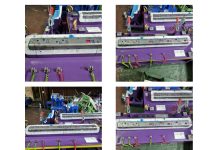Ready, Set, Press! Hot Press Heating Reduced from 5 Minutes to 5 Seconds Power cost reduced by 20%, Facility area reduced by 90%
Asteer Co. Ltd. in Japan designs and manufactures crash-safety parts, fuel parts and doors across nine operational plants, seven of which are in Soja city. In reinforcing parts, such as bumpers etc. for safety, they have persistently developed new ways to increase fuel consumption efficiency through lightweighting; whilst simultaneously aiming for cost reduction as added value for customers.
AHSS 980MPa sheets are used to meet their targets and even an impressive 1180MPa in recent years, which carry their own issues in sheet metal forming. Conventional cold-forming methods don’t quite cut it, leading their engineers to fully embrace the future; hotforming for ultra-high tensile strength steels.
Not only that, but they have successfully advanced the field of hotforming, by developing their own ‘direct resistance heating hot press method.’ This is enabled by the unique ‘partial non-quenching technology’ which has been already applied to mass production for bumpers and door crash parts since 2013.

Fig 1: The Smart Hot Press Method
In their distinct hot press method sheet steel is heated to 900°C, at which point it is pressed and quenched at the same time to harden the sheet. This renders the material into a high-strength panel of 1470MPa!
By all reports their method is easier than cold-forming, with springback kept to a minimum. However, let’s be clear: the commonly practiced hot press method is costly, as it requires the large scale furnaces to heat the sheet.
As an alternative Asteer harnessed Joule conduction to heat the steel sheet, resulting in low cost, low energy and high productivity. This hot press method, a unique technology of Asteer, is named “Smart Hot Press” or SHP (patented).
Mr. Shimotsu, Manager of Development said ‘The main feature of the SHP method is the “partial non-quenching technology”, in which a part of the steel sheet is not quenched. With this, the deformation mode when crashed can be optimized, which leads to a reduced number of parts and optimal design. Furthermore, it avoids the fracturing of welded parts, and it also prevents delayed fractures, which might occur with cold pressing and piercing, as well as avoiding the need for costly laser cuts.’
What’s best, compared to the 2-5 minutes it takes for conventional hot pressing at a furnace – the new SHP method with its direct resistance heating takes 5 to 15 seconds!

Fig 2: The Hotpress does it in a single stroke.
With SHP it’s no longer necessary to heat the overall furnace, meaning energy efficiency is improved by three times! As a result, production cost of a part can be reduced by 20% in comparison to the use of a furnace, and the space taken at the facility can be reduced by 90%.
 Asteer’s unique SHP method is highly acclaimed: 2013 award for excellence at the 25th Small Business Excellent New Technology, 2015 New Product Award, and 2015, another award for excellence at the 6th Monozukuri Japan Award, organized by the Ministry of Economy, Trade and Industry (METI).
Asteer’s unique SHP method is highly acclaimed: 2013 award for excellence at the 25th Small Business Excellent New Technology, 2015 New Product Award, and 2015, another award for excellence at the 6th Monozukuri Japan Award, organized by the Ministry of Economy, Trade and Industry (METI).
From 2013 onwards the method has been used for door impact beams, and by June 2016 its use resulted in a sales production well above 1.07 million. But the question we wanted to know is where did metal forming simulation come in?
In part 2 of this article we’ll take a look at the simulation methods and the AutoForm tools employed by Asteer to achieve such brilliant success.
Read Part 2 here. For new readers don’t forget to subscribe to our blog. We’ll never send you marketing emails, but once a month you’ll get a recommendation for the top three posts of each month.













